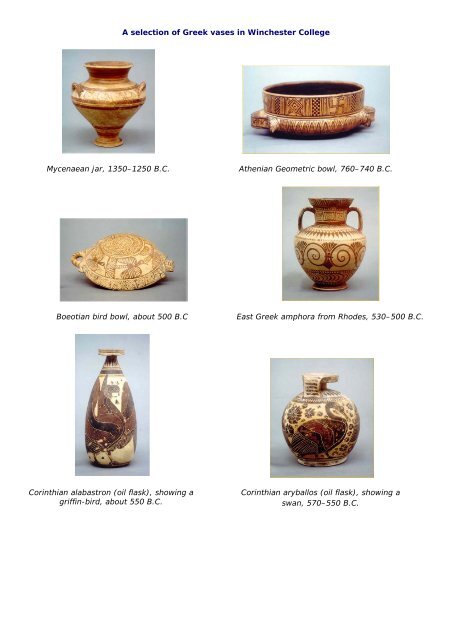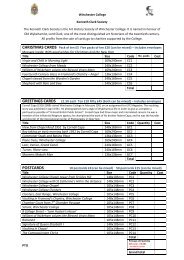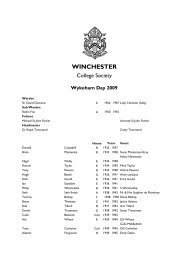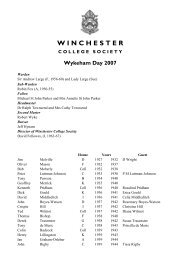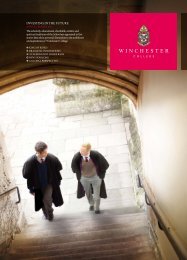Greek vases - Winchester College
Greek vases - Winchester College
Greek vases - Winchester College
Create successful ePaper yourself
Turn your PDF publications into a flip-book with our unique Google optimized e-Paper software.
A selection of <strong>Greek</strong> <strong>vases</strong> in <strong>Winchester</strong> <strong>College</strong><br />
Mycenaean jar, 1350–1250 B.C. Athenian Geometric bowl, 760–740 B.C.<br />
Boeotian bird bowl, about 500 B.C East <strong>Greek</strong> amphora from Rhodes, 530–500 B.C.<br />
Corinthian alabastron (oil flask), showing a<br />
griffin-bird, about 550 B.C.<br />
Corinthian aryballos (oil flask), showing a<br />
swan, 570–550 B.C.
Athenian black figure hydria (water jar) showing Hercules leading Cerberus from the underworld. 510–<br />
490 B.C.<br />
Athenian red figure cup,<br />
showing athletes holding<br />
jumping weights. On the<br />
inside of the cup, a longbearded<br />
satyr holding a<br />
Bacchic wand (‘thyrsos’) and<br />
wine jug. The cup is the<br />
name vase of the<br />
“<strong>Winchester</strong> Painter”. Other<br />
cups by this painter are in<br />
museums in Dresden and<br />
Florence. 520–500 B.C.<br />
The <strong>College</strong> collection of <strong>vases</strong> has been published by John Falconer and Thomas<br />
Mannack as part of the Corpus Vasorum Antiquorum (Oxford University Press,<br />
2002, ISBN 0-19-726257-0).
A number of <strong>vases</strong> disappeared from the <strong>College</strong> in the 1960s: the two illustrated below have recently<br />
been recovered.<br />
Athenian red figure lekythos<br />
(oil flask), showing a hunter,<br />
about 450 B.C.<br />
Athenian red figure oinochoe<br />
(wine jug) with two women, one<br />
seated and juggling with balls of<br />
wool, the other standing holding<br />
a wool basket, 420–400 B.C.<br />
Any information about the present whereabouts of the still missing <strong>vases</strong> shown below would be<br />
welcomed by the museum curator who can be contacted at curator@wincoll.ac.uk<br />
Athenian red figure lekythos:<br />
Zeus seated on a throne.<br />
Ascribed to the Icarus Painter.<br />
Athenian oinochoe<br />
in the form of a<br />
woman’s head.<br />
Corinthian alabastron:<br />
bull’s head, with a swan<br />
on the reverse.<br />
Also missing are a pelike by the Washing Painter showing two women with a wool basket (on the<br />
reverse a youth) and a miniature oinochoe showing a baby boy and girl at play.<br />
Information would also be welcome about a missing Egyptian limestone relief of the goddess Astarte<br />
standing on a lion. It is said to have been painted in red, yellow, blue and black, and was given to the<br />
<strong>College</strong> in 1951.
Among other missing Egyptian items are:<br />
i. a stele of Aset-ueret, shown adoring the Gods of the Dead, Osiris, Isis, and<br />
Nephthys: above is the winged moon disk, below, an inscribed prayer to Osiris.<br />
26th dynasty. Presented by A.P Ralli in the early 1900s.<br />
ii. a seated bronze statue of the youthful Horus, with inlaid eyes and engraved<br />
collar, wearing the double crown and with the plaited lock of youth, said to have<br />
been found on the Acropolis at Athens.


